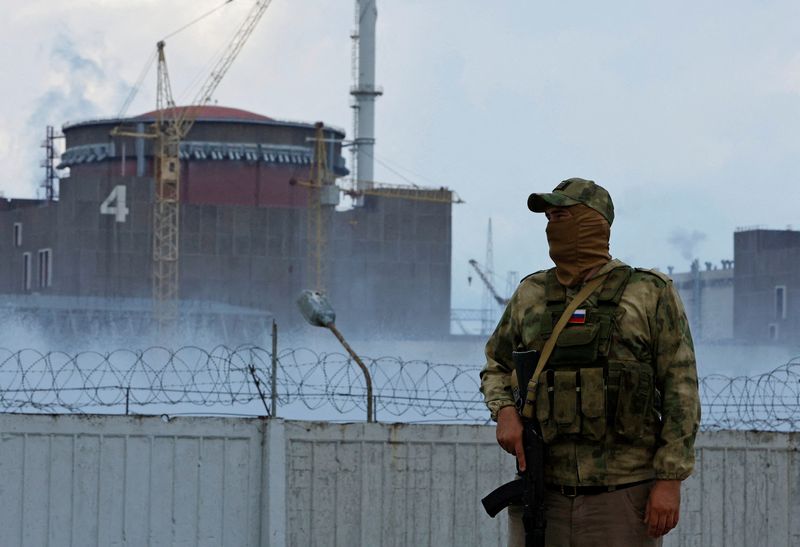LONDON (Reuters) - The Zaporizhzhia nuclear power plant in southern Ukraine has been shelled in recent days, opening up the possibility of a grave accident just 500 km (around 300 miles) from the site of the world's worst nuclear accident, the 1986 Chernobyl disaster.
WHAT IS IT?
The Zaporizhzhia nuclear power plant has six Soviet-designed VVER-1000 V-320 water-cooled and water-moderated reactors containing Uranium 235, which has a half life of more than 700 million years.
It is Europe's biggest nuclear power plant and one of the biggest in the world. Construction began in 1980 and its sixth reactor was connected to the grid in 1995.
Pressurised water is used to transfer heat away from the reactor and to slow down neutrons to enable the Uranium 235 to continue its chain reaction.
If the water was cut, and auxiliary systems such as diesel generators failed to keep the reactor cool due to an attack, then the nuclear reaction would slow though the reactor would heat up very swiftly.
At such high temperatures, hydrogen could be released from the zirconium cladding and the reactor could start to melt down.
At least two reactors are still working at the plant.
WHAT ABOUT THE SPENT FUEL?
Besides the reactors, there is also a dry spent fuel storage facility at the site for used nuclear fuel assemblies, and spent fuel pools at each reactor site which are used to cool down the used nuclear fuel.
"The basins of spent fuel are just big pools with uranium fuel rods in them - they are really hot depending on how long they have been there," said Kate Brown, an environmental historian at the Massachusetts Institute of Technology whose book "Manual for Survival" documents the full scale of the Chernobyl disaster.
"If fresh water is not put in then the water will evaporate. Once the water evaporates then the zirconium cladding will heat up and it can catch on fire and then we have a bad situation - a fire of irradiated uranium which is very like the Chernobyl situation releasing a whole complex of radioactive isotopes."
An emission of hydrogen from a spent fuel pool caused an explosion at reactor 4 in the Fukushima nuclear disaster in 2011.
According to a 2017 Ukrainian submission to the IAEA, there were 3,354 spent fuel assemblies at the dry spent fuel facility and around 1,984 spent fuel assemblies in the pools.
That is a total of more than 2,200 tonnes of nuclear material excluding the reactors, according to the document https://www.iaea.org/sites/default/files/national_report_of_ukraine_for_the_6th_review_meeting_-_english.pdf.
WHO CONTROLS IT?
After invading Ukraine on Feb. 24, Russian forces took control of the plant in early March.
Ukrainian staff continue to operate it, but special Russian military units guard the facility and Russian nuclear specialists give advice.
If there was a nuclear accident, it is unclear who would deal with it during a war, said Brown.
"We don't know what happens in a wartime situation when we have a nuclear emergency," Brown said. "In 1986 everything was running as well as it ran in the Soviet Union so they could mobilise tens of thousands of people and equipment and emergency vehicles to the site."
"Who would be taking charge of that operation right now?"
WHAT HAS HAPPENED SO FAR?
The plant was struck in March but there was no radiation leak and the reactors were intact. Both Russia and Ukraine blamed each other for that strike.
In July, Russia said Ukraine had repeatedly struck the territory of the plant with drones and missiles. Pro-Ukrainian social media said "kamikaze drones" had struck Russian forces near the plant.
Reuters was unable to immediately verify battlefield accounts of either side.
- Aug. 5: The plant was shelled twice. Power lines were damaged. An area near the reactors was hit.
Russia said that Ukraine's 45th Artillery Brigade also struck the territory of the plant with 152-mm shells from the opposite side of the Dnipro river. Ukraine's state nuclear power company, Energoatom, said Russia fired at the plant with rocket-propelled grenades.
- Aug. 6: shelled again, possibly twice. An area next to the dry spent nuclear fuel storage facility was hit.
Energoatom said Russia fired rockets at the plant. The Russian forces said Ukraine struck it with a 220-mm Uragan rocket launcher.

- Aug. 7: shelled again
Russia said Ukraine's 44th Artillery Brigade struck the plant, damaging a high-voltage line. Russia's defence ministry said power at reactors 5 and 6 was reduced to 500 megawatts.